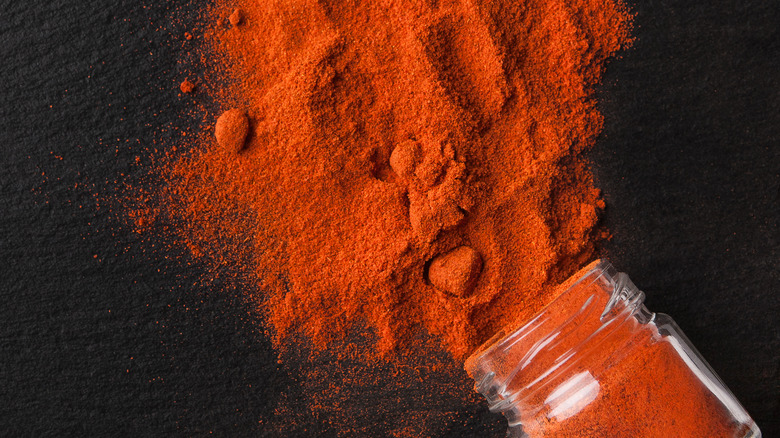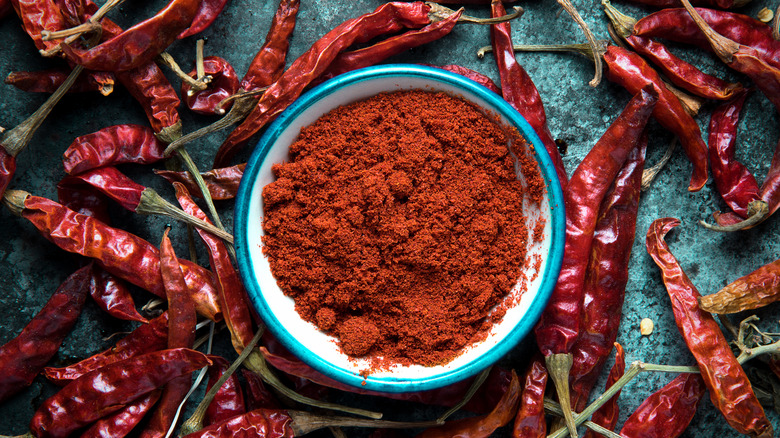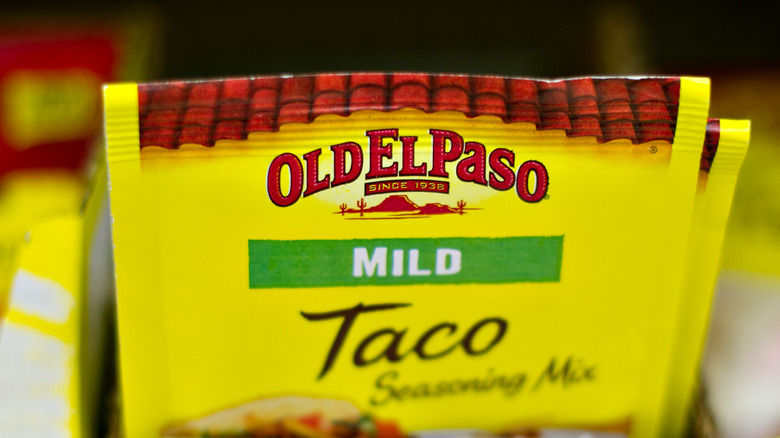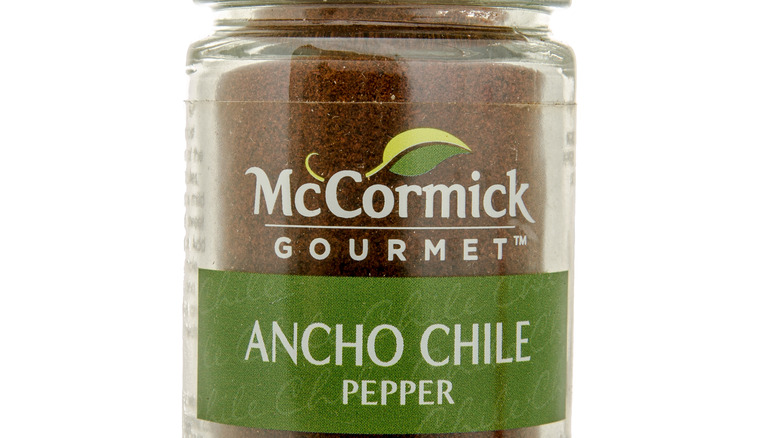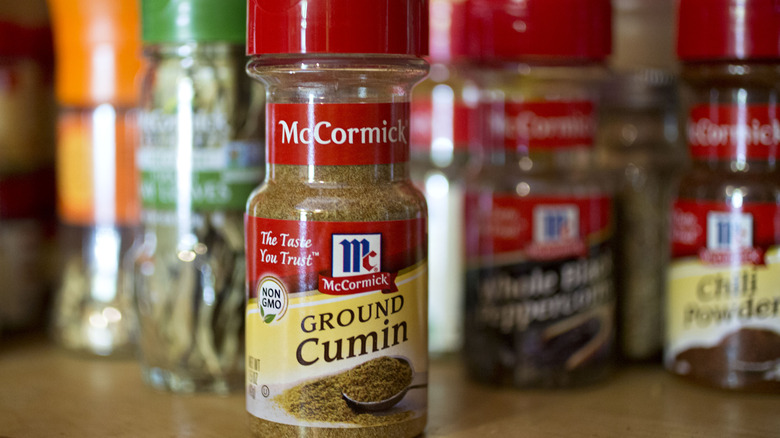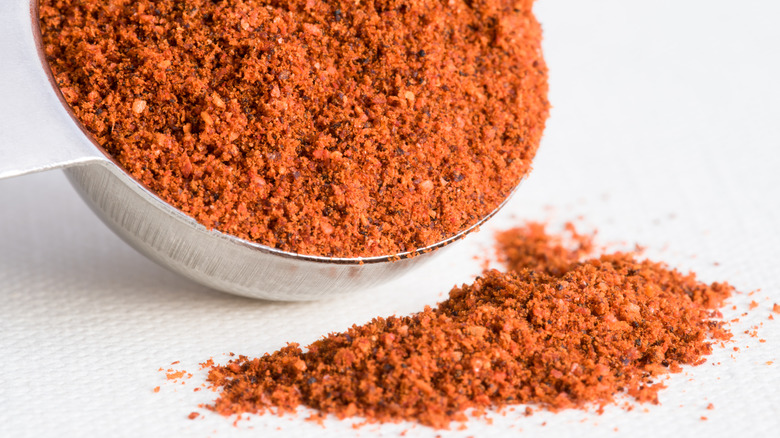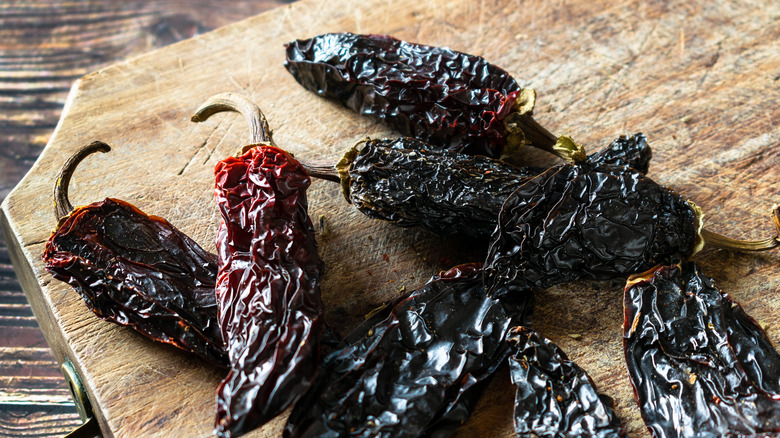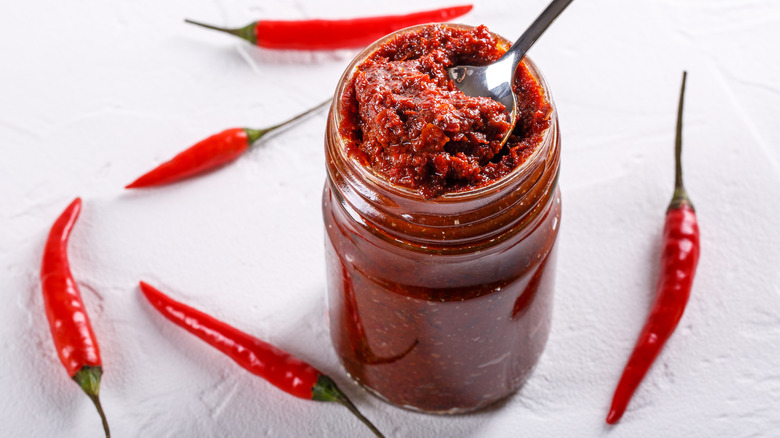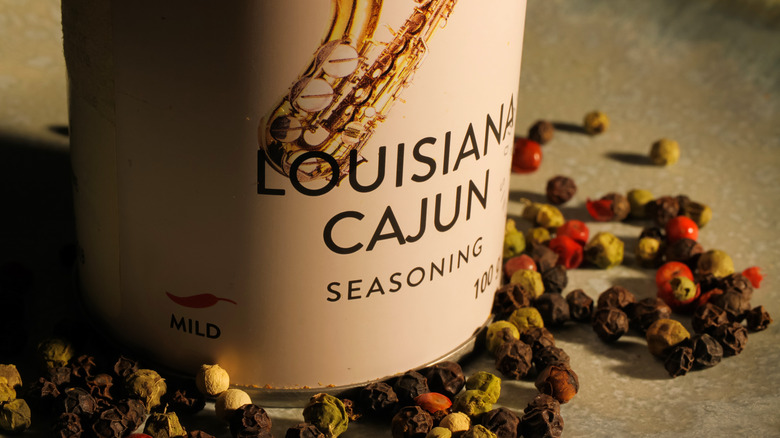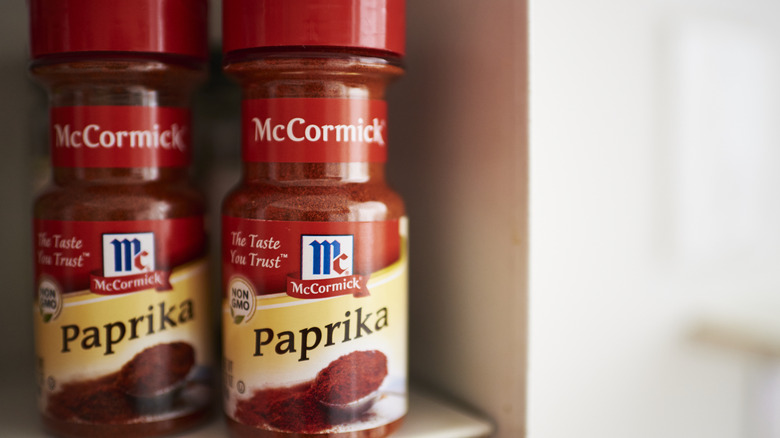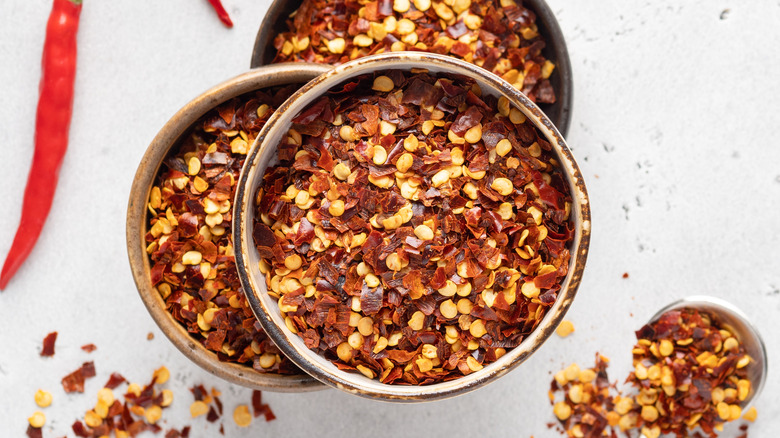10 Best Substitutes For Chili Powder
Chili powder, that ground seasoning with a deep red hue, is a spice rack staple that adds a kick of flavor and spice to any dish. It's a common ingredient in chilis and other Mexican and Tex-Mex recipes like tacos, enchiladas, beans, and stews. (Via The Kitchn.) Chili powder isn't just a single dried spice — it's actually a blend of several spices. The exact spices used and quantity of each can vary between brands or homemade versions, but there are a few spices that most chili powders all have.
One of those ingredients, according to Spruce Eats, is ground cayenne pepper. Cayenne gives heat to chili powder, as well as that red color. Cumin and garlic powder are two other primary ingredients of chili powder, both of which help create the savory flavor that's the basis of so many Latin American dishes. Other ingredients that may go into different chili powders include paprika (even more red color), coriander, Mexican oregano, and salt. (Note: the label should say chili powder with an "i". A spice labeled chile powder with an "e" is different because it's a single pepper, not a blend.)
So what exactly are you supposed to do when you scour the cabinet for chili powder, and you find that you're completely out? It's ok! You probably have one or many spices in your drawer that you can substitute for chili powder. Here are the 10 best substitutes and how to use them.
1. Cayenne Pepper
Because cayenne pepper is a principal ingredient in chili powder, it makes sense to reach for some as a substitute. However, this is not a 1:1 substitute. Spruce Eats says that in chili powder the fiery heat of cayenne is muted because of all the other spices in the mixture. But a bottle labeled cayenne contains only dried and ground cayenne peppers, and that means it will set your mouth ablaze!
For every teaspoon of chili powder called for in your recipe, use only an 1/8 of a teaspoon of cayenne pepper. Then, taste your dish to evaluate the spiciness before you add more.
Remember too, that cayenne pepper is only one part of chili powder. It will give you the heat and a some chili pepper essence, but not the rest of the flavors that chili powder brings to the dish. You can build these in, though, by adding in some form of those other ingredients, like fresh or powdered garlic, a pinch of salt, or a squeeze of lime juice to mimic the citrusy flavor of coriander.
2. Taco Seasoning
If you dig around in your pantry, there's a decent chance you'll find a dusty, forgotten envelope of taco seasoning. And that's great news because you can totally use it (or your own homemade taco seasoning) as a chili powder substitute. Chile Pepper Madness shares that taco seasoning blends have many of the same ingredients as chili powder, including cumin, paprika, garlic, and ground chile peppers. Adding in taco seasoning will give your recipe a boost of flavor that works especially well when seasoning meats for tacos, nachos, and burritos.
Because it's taco seasoning, it will have a definite "taco" flavor. SPICEography says that most taco seasoning blends go heavy with cumin and oregano. These spice flavors will be the most prominent when you use taco seasoning in place of chili powder. It will have a little heat, depending on the blend, and you can always add more by stirring in a pinch of cayenne or adding fresh, sliced hot peppers.
Like chili powder, taco seasoning is a blend of spices, so you can sub in the same amount.
3. Ancho Chile Powder
This is one of those chile powder vs. chili powder situations we told you about! Ancho chile powder is made of a single dried and ground pepper. Anchos are made by drying poblano peppers, the long, dark green peppers that are used extensively in Latin American dishes like traditional mole sauces and cheese-stuffed chile Rellenos. Ancho peppers can be found in whole, dried form or ground into powder.
Try subbing in an equal amount of ground, ancho chile pepper for the chili powder called for in your recipe. A regular chili powder blend includes cayenne pepper, and using Ancho chile powder will bring that earthy, pepper flavor to your recipe, as well as a little bit of smokiness.
Because poblanos are on the mild side, your ancho chile powder will have some heat, but less so than cayenne pepper. You can add just the ground ancho chile pepper or add in additional, spicy ingredients if you need to bring the heat level closer to that of regular chili powder.
4. Cumin
Ground cumin has a warm, rich flavor that's inextricably linked with Mexican and Latin American foods, although it's also used in Middle Eastern and other cuisines. According to Spruce Eats, it's one of the primary ingredients in chili powder, so it makes sense that it can be used when no chili powder can be found. Cumin isn't spicy, but it is very flavorful, so it will go a long way to replacing the flavor of chili powder in your recipe, especially in chilis and to flavor meats.
To use it as a substitute for chili powder, Healthline says you can use up to two times as much cumin for the chili powder specified. This is because cumin doesn't have the heat of chili powder. However, because ground cumin does have a lot of flavor, start by using the same amount that the recipe specifies for chili powder, and adjusting from there.
You can also add garlic powder for savory flavor or some cayenne for a little spice. Adding paprika will put give your dish some of the red color that chili powder usually imparts.
5. Chipotle Pepper Powder
Using this spice in place of chili powder will bring a big dose of flavor to your dish. Chipotle pepper powder is a type of chile powder, meaning there's just one kind of pepper in there and no other ingredients. According to Chili Pepper Madness, chipotle peppers are made from fully ripened, red jalapeño peppers. The peppers are smoked for a long period, which gives them a deep, smoky flavor. You're probably used to seeing chipotles packed in a spicy, tomato-based adobo sauce in cans, but chipotle pepper powder is made just from the dried peppers.
Jalapeños are moderately spicy, scoring between 2,500 and 5,000 on the Scoville heat units scale, and chipotle pepper powder will have this same level of spice. This heat and the red color are two things that make chipotle pepper powder a good substitute for chili powder.
However, chipotle peppers have a very distinctive smoky and sweet flavor, similar to barbecue sauce, that is much different than the flavor of regular chili powder. For this reason, PepperScale suggests starting with half the amount called for of chili powder, then tasting your dish before to see if it needs more.
6. Dried Chile Peppers
After reading about using chipotle pepper and ancho chile powders as substitutes, this suggestion should come as no surprise. After all, before they were ground and bottled, they were whole, dried peppers! In addition to dried anchos and chipotles, Saveur shares that other readily available dried peppers include cascabel, guajillo, chiles de arbol, and pequin. Dried chiles can be reddish in color with fruity flavors or dark, almost black with a sweetness like that of raisins. The level of heat varies with each type; for example, pequin peppers are very spicy, while cascabel and guajillo peppers are milder.
The smoky and spicy flavors of dried chiles work very well as a substitute for chili powder. To make a ground spice, slice open the dried peppers, then remove and discard the seeds and stem before grinding them in a food processor. According to GourmetSleuth, one dried ancho chile pepper makes about a tablespoon of ancho powder. With a milder pepper like ancho, you can make an equal substitution for chili powder. However, if you're using a dried pepper with more heat, you're better off starting with half the amount and tasting your dish before adding more.
Saveur says dried peppers can also be rehydrated in boiling water, then blended to make a pepper purée to stir into soups, chilis, moles, or marinades. As with ground, dried chiles, start with half the amount specified for chili powder, then add more purée to taste.
7. Harissa
Though not all kitchens have a jar of harissa on hand, if you do, it's a great replacement for chili powder. Harissa is a type of chili paste that's a common accompaniment to North African and Middle Eastern dishes. It's made by blending red chiles, roasted red peppers, and olive oil with spices that vary from cook to cook, but typically include cumin and garlic. Chiles, cumin, garlic ... you can definitely see the similarities to chili powder already!
According to SPICEography, harissa can also be found in powdered form, made with the dried red chiles, cumin, garlic, and other spices. Harissa can be on the mild side or very spicy, and the label will tell you which one you're working with. Whether you're using dried harissa or harissa paste, use the same amount as the chili powder your recipe calls for.
If your recipe relies on the spices being in dry form (like a dry rub, for example) then ground harissa should be used instead of the paste. If your harissa is mild and you want more heat, boost it with a little cayenne pepper or red pepper flakes.
8. Cajun Seasoning
This may seem like a less likely choice to grab as a substitute, as chili powder is most often found in Latin American dishes, and Cajun seasoning is specific to Louisiana cuisine. The two blends do have a few spices in common, though, and Cajun seasoning will give your recipe a boost of flavor when there's no chili powder available.
Cajun spice blends are meant to replicate the flavors of the dishes of the Cajun people, who came from France to Canada and eventually settled in Louisiana in the 1700s. Cajun food is loaded with robust flavors, and the spice blend is potent, too. The seasoning will typically have a hefty dose of salt, as well as black and white peppercorns, ground cayenne pepper, onion powder, garlic powder, and paprika. Cajun seasoning usually has a little heat from the cayenne; how much will vary between brands. Creole is sometimes used interchangeably with Cajun when referring to this seasoning blend, though technically true Creole dishes are milder and more herby.
SPICEography recommends substituting an equal amount of Cajun seasoning for chili powder in your recipe. Keep in mind though that because Cajun seasoning contains a fair amount of salt, you may want to adjust how much additional salt you add to your dish. Cajun seasoning works with many dishes and is especially tasty in marinades, sauces for meats or fish, and dry rubs.
9. Paprika
Strikingly red paprika can be substituted for chili powder. However, it's important to figure out which kind of paprika you have. Will it give your recipe more flavor, some spiciness, or just a big dose of red color?
According to Masterclass, there are three types of ground paprika. All are made from dried, red peppers, but the types of peppers and the way they're dried make the difference in the flavors and heat. Regular paprika, which at the store may be simply labeled "paprika" has very little by way of flavor, either sweet or savory. This is the kind of paprika that you see sprinkled over deviled eggs and other dishes to give a dash of color.
Hungarian paprika is used extensively in Hungary in traditional dishes like paprikash and goulash. There are several varieties of Hungarian paprika, and they can be sweet or very spicy. (Sometimes, Hungarian paprika is labeled as hot paprika.) The third type is Spanish paprika, which may be labeled as pimentón. Masterclass says that Spanish paprika varieties also range from mild to spicy, but they have a smoky flavor achieved by drying peppers over wood fires.
Pepperclass says that paprika can be substituted in equal amounts for chili powder, but it does depend on which paprika you have. Hot paprika will be spicier than chili powder, so start with half or less than the amount called for. With Spanish paprika, remember that you'll get smokiness as well as spice.
10. Crushed Red Pepper Flakes
This is another spice home cooks are likely to have on hand, and it's the same crushed red pepper flakes that you find at pizza joints in little shakers on the table. Bon Appétit says that red pepper flakes are made by quickly drying and then grinding cayenne peppers — that's the same pepper that gives a spicy kick and red color to chili powder. One thing that red pepper flakes have that other ground peppers don't is the seeds, which are the yellowish flecks in the mixture. Cayenne peppers are already spicy, and including the seeds makes this spice even hotter.
Spruce Eats suggests substituting crushed red pepper for half the amount called for of chili powder. That's because the pepper flakes are so much spicier than chili powder blends. Once you taste your dish, you can add more pepper flakes to taste.
In addition to the heat, this substitute will bring chile pepper flavor to your recipe, too. Pepperscale recommends grinding the pepper flakes with a mortar and pestle, or a spice grinder, to make a finer texture closer to that of chili powder.
